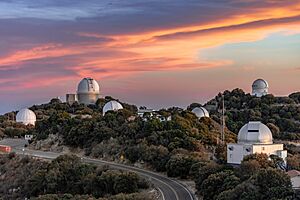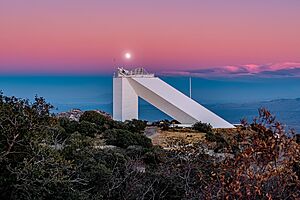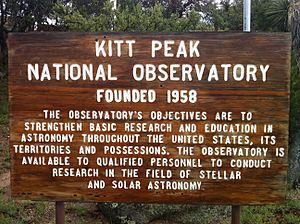Kitt Peak National Observatory facts for kids
Quick facts for kids 
Various telescopes at the Kitt Peak National Observatory (KPNO) in the Quinlan Mountains
|
|||||||||||||||||||||||||||||||||||||||||||||||||
| Location | Kitt Peak, Arizona, US | ||||||||||||||||||||||||||||||||||||||||||||||||
|---|---|---|---|---|---|---|---|---|---|---|---|---|---|---|---|---|---|---|---|---|---|---|---|---|---|---|---|---|---|---|---|---|---|---|---|---|---|---|---|---|---|---|---|---|---|---|---|---|---|
|
|||||||||||||||||||||||||||||||||||||||||||||||||
The Kitt Peak National Observatory (KPNO) is a famous place for studying space. It is located on Kitt Peak in the Quinlan Mountains of Arizona, USA. This observatory is special because it has more than twenty optical telescopes and two radio telescopes. This makes it one of the biggest collections of space-watching tools in the northern part of Earth.
KPNO was started in 1958. It used to have the largest solar telescope in the world. Many big telescopes from the late 1900s in the United States are also found here. The observatory is now managed by NOIRLab.
In June 2022, a wildfire called the Contreras Fire caused everyone to leave Kitt Peak. The fire reached the top of the mountain. Four buildings that were not used for science, like a place where people slept, were lost in the fire. But the observatory reopened to visitors in September 2023.
Contents
About Kitt Peak Observatory
Kitt Peak was chosen in 1958 to be the home of a national observatory. This was done by its first director, Aden B. Meinel. The land is leased from the Tohono Oʼodham Nation through a long-term agreement. The second director was Nicholas U. Mayall, who led from 1960 to 1971.
The biggest optical telescopes at KPNO are the Mayall 4-meter telescope and the WIYN 3.5-meter telescope. There are also many other telescopes of different sizes. The McMath–Pierce solar telescope was the largest solar telescope in the world for many years. It was also the largest telescope that had no secondary mirror blocking the light. The ARO 12m Radio Telescope is also located here.
Kitt Peak is well-known for hosting the first telescope ever used to look for near-Earth asteroids. These are space rocks that come close to Earth. Scientists used this telescope to figure out the chances of an asteroid hitting our planet.
Visiting Kitt Peak
Kitt Peak offers many fun programs for the public. You can learn about the observatory and even look through telescopes yourself!
- Daytime tours: These tours teach you about the observatory's history. You also get to see a large research telescope up close.
- Nightly Observing Program (NOP): Visitors can come in the late afternoon. You can watch the sunset and then use binoculars and telescopes to see stars and planets.
- Overnight Telescope Observing Program (OTOP): This is a special program where you get a whole night to observe the sky. You work one-on-one with an expert. You can even take pictures of space using special cameras.
A big project that started in the 2010s is the Dark Energy Spectroscopic Instrument (DESI). This instrument is used with the 4-meter Mayall telescope. It helps scientists study distant galaxies to understand how the universe is expanding. It also helps them learn about dark energy, which is a mysterious force in space.
History of Discoveries
The Kitt Peak National Observatory officially opened on March 16, 1960. When it opened, it had a 36-inch telescope and other buildings ready. Work was already happening on a larger 84-inch telescope. This 84-inch telescope (which is 2.1 meters) saw its "first light" in September 1964. "First light" means it was used for the first time to look at the sky.
Over the years, many telescopes were built on the mountain. Scientists at KPNO have made many important discoveries. For example, they have studied dark matter, measured distances in space, and looked at very distant galaxies. The observatory also has many programs to teach people about space.
In 2018, KPNO started planning a new center called the Windows on the Universe Center for Astronomy Outreach. This center aims to share the wonders of astronomy with even more people.
Amazing Discoveries
In 1976, the Mayall Telescope was used to find methane ice on the dwarf planet Pluto. This was an important discovery about Pluto's surface.
In the year 2000, the 90-centimeter Spacewatch telescope helped discover a body in the Kuiper belt called 20000 Varuna. An astronomer found this object by noticing it moved very slowly when comparing images.
Weather at Kitt Peak
Kitt Peak is high up in the mountains. Because of this, it has a cooler and wetter climate than most of the Sonoran Desert around it. This type of climate is called a subtropical highland climate.
Images for kids
-
A wide view of Kitt Peak from the Warner and Swasey Observatory
-
Another wide view from Kitt Peak's Mayall 4-meter Observatory
| Climate data for Kitt Peak, Arizona (Elevation 6,790ft) | |||||||||||||
|---|---|---|---|---|---|---|---|---|---|---|---|---|---|
| Month | Jan | Feb | Mar | Apr | May | Jun | Jul | Aug | Sep | Oct | Nov | Dec | Year |
| Record high °F (°C) | 71 (22) |
75 (24) |
78 (26) |
88 (31) |
90 (32) |
98 (37) |
98 (37) |
94 (34) |
91 (33) |
89 (32) |
87 (31) |
72 (22) |
98 (37) |
| Mean daily maximum °F (°C) | 49.6 (9.8) |
50.8 (10.4) |
54.3 (12.4) |
61.7 (16.5) |
70.4 (21.3) |
79.5 (26.4) |
80.4 (26.9) |
78.0 (25.6) |
74.9 (23.8) |
66.9 (19.4) |
56.8 (13.8) |
50.0 (10.0) |
64.4 (18.0) |
| Mean daily minimum °F (°C) | 33.0 (0.6) |
33.6 (0.9) |
35.8 (2.1) |
41.3 (5.2) |
49.2 (9.6) |
58.5 (14.7) |
60.8 (16.0) |
59.8 (15.4) |
57.0 (13.9) |
48.6 (9.2) |
39.5 (4.2) |
33.7 (0.9) |
45.9 (7.7) |
| Record low °F (°C) | −3 (−19) |
−2 (−19) |
9 (−13) |
15 (−9) |
24 (−4) |
33 (1) |
40 (4) |
42 (6) |
35 (2) |
20 (−7) |
12 (−11) |
6 (−14) |
−3 (−19) |
| Average precipitation inches (mm) | 1.77 (45) |
1.60 (41) |
1.80 (46) |
0.55 (14) |
0.44 (11) |
0.45 (11) |
4.38 (111) |
4.53 (115) |
2.36 (60) |
1.50 (38) |
1.14 (29) |
2.65 (67) |
23.16 (588) |
| Average snowfall inches (cm) | 3.0 (7.6) |
4.3 (11) |
4.1 (10) |
1.2 (3.0) |
0.1 (0.25) |
0.0 (0.0) |
0.0 (0.0) |
0.0 (0.0) |
0.0 (0.0) |
0.3 (0.76) |
1.2 (3.0) |
3.8 (9.7) |
18.1 (46) |
| Source: The Western Regional Climate Center | |||||||||||||
See also
 In Spanish: Observatorio Nacional de Kitt Peak para niños
In Spanish: Observatorio Nacional de Kitt Peak para niños
- List of astronomical observatories
- List of radio telescopes
- List of telescope types




